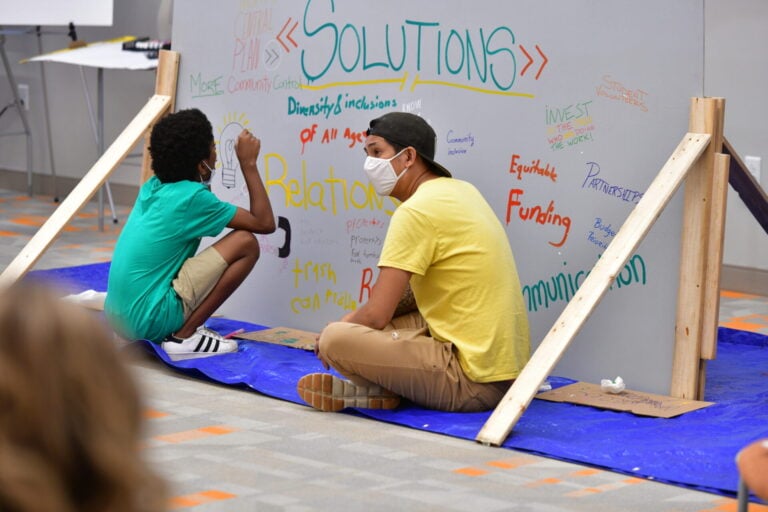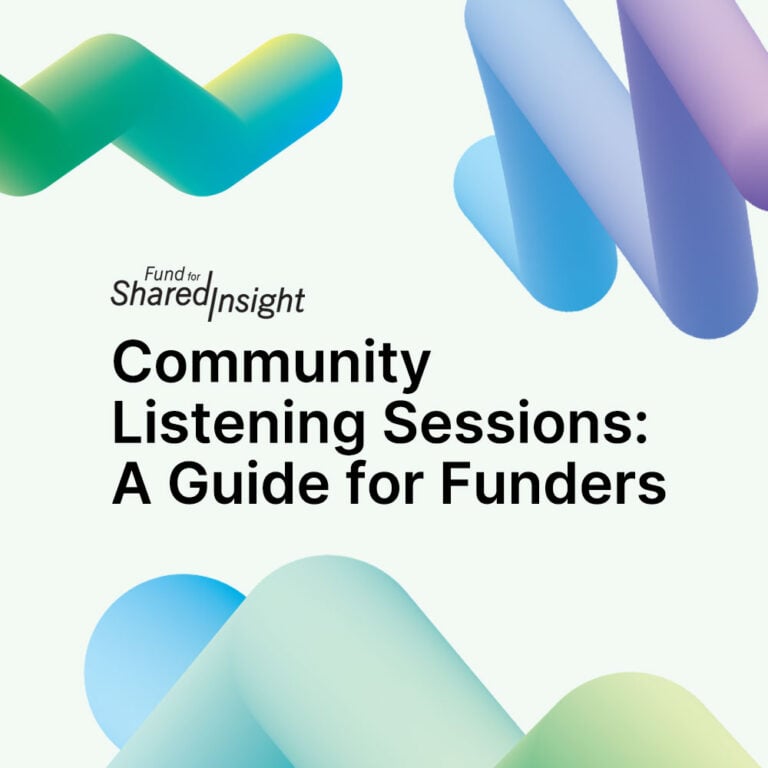Tools & Resources to Shift Power to Communities
Browse Menu
Looking at your role/function within your foundation.
What are listening practices that can shift power?
Assess how you are listening through a set of reflection questions.
Survey, convene, or meet with your community
Working with nonprofits through client-feedback programs, like Listen4Good, or through trust-based philanthropy approaches provide funders opportunities for indirect listening and learning. In direct listening, foundation staff or board members are the primary listeners or recipients of the insights, through activities such as hosting listening sessions, convening focus groups, and conducting surveys. Funders might also commission a third party, such as research firms or consultants, to gather input for them.
The key is that your listening activities are not one offs; that they are systematic, ongoing, and part of authentic partnerships and communications.
- Pro Tip
Make sure to take participant accessibility into account in all your listening activities, such as incorporating disability inclusion practices when convening meetings and oversampling underrepresented groups when conducting surveys. Current Global created a website to help you ensure that all your communications are accessible to people with disabilities.
Get going with these tools and resources
Learn how to host listening sessions that encourage meaningful community engagement and empower those most affected — yet often least consulted — to influence your foundation’s work.
Find practical resources on how to make your virtual and in-person meetings and events more inclusive, such as an accessibility checklist and much more.
This guide will help you and your foundation colleagues reimagine power dynamics and level the playing field on which you design research, generate knowledge, and make decisions. It provides an equity-based approach to research that offers a path to restoring communities as authors and owners.
Get inspired by what other funders are working on

During a process to reimagine its strategy, Deaconess Foundation worked with a consultative project team to engage people in its region (Missouri and Illinois) and nationally, ultimately collecting feedback from 663 community members and policy analysts through neighborhood and community gatherings, grant partner focus groups, one-on-one interviews, and national peer funder conversations.
The purpose of the listening was to give the foundation a better sense of what mattered to individuals and their families and how its strategy could more closely align with their hopes and aspirations for the future. One of the listening exercises employed at public events was designed around posters that listed racial-equity benchmarking indicators. Attendees were invited to write their zip code on sticky notes, placing them on the indicators that best reflected an area in their life in which they wanted to see change. They were also invited to add written feedback about why they chose a certain indicator, how changes related to it would impact their lives, and what organizational values Deaconess would need to adopt to help achieve those changes.


The William and Flora Hewlett Foundation considers itself an experienced donor in the field of family planning, yet when its Gender Equity and Governance Program was refreshing its strategic plan, the foundation turned to design thinking, a way of problem solving by deciphering what people really want through watching and listening. Hewlett brokered a partnership between IDEO.org and Marie Stopes International to engage adolescent girls in Zambia in project design. The result was a new approach that better connected with teenagers around issues of reproductive health.


To follow up on themes heard in its community listening sessions with low-income workers in California, The James Irvine Foundation commissioned a survey of more than 3,300 residents to gain insights into the unique experiences of different demographic groups (e.g., by region, age, race/ethnicity). Learnings from the listening sessions and survey were useful, but Irvine realized that the survey’s sample of Asian-Americans and Pacific Islanders had painted dozens of nationalities and ethnicities as a monolithic group. To be able to see the unique challenges that exist among different groups, Irvine followed up with another survey, this time including 2,600 Californians from nine distinct AAPI ethnic groups.


Through its program, Listening to Mothers in California, the California Health Care Foundation gathered perspectives from roughly 2,500 people who responded to a survey focusing on the experiences, outcomes, and views of childbearing women. The foundation aimed to hear especially from under-represented groups, such as by offering the survey in both English and Spanish and by oversampling Black women.
Explore this menu to spark the changes you want to see.
Mix and match to find the examples, resources, and reflections best suited to help you and your organization shift power to the people and communities at the heart of your work.
How to use the menu
Funders are moving toward listening and participatory practices at different rates and from different starting points and perspectives. We also know that shifting power is not easy work and requires a strong internal commitment and continuous learning. It’s best to be clear on your organization’s motivations, capabilities, and goals. As you engage with this menu, consider your funding practices, operations, policies, and values — and then identify where change will best serve your foundation and the people and communities you seek to serve.
We recommend examining the menu’s resources and examples with a willingness to turn kernels of ideas into something right for you. No matter where you start or the path you travel through this menu, we suggest spending time on the reflection questions, perhaps engaging colleagues to help you and your organization better understand and prepare for what it means to listen to shift power.
Our Participatory Philanthropy Toolkit, included as a resource in the menu, has a Funder Readiness Assessment that can be adapted to different listening practices and help prepare you to make changes in your priorities and practices.
How we choose the items
We offer a range of examples and resources because there are no one-size-fits-all solutions; and we share them in a menu format so you can choose what’s interesting or relevant to you and your foundation. We don’t rank the practices or the organizations employing them or intend to signal that any featured funder has met its listening goals across the board. Each example represents only a moment in time — a practice one of your peers told us (or an intermediary) about, and that we hope might inspire you to enhance your own listening work.
Similarly, we do not rank the resources, though we did select them based on a set of criteria, including:
- We and/or our partners have personally used the resource and find it is high-quality, promotes impact, and aligns with our power analysis
- The resource is widely and publicly available (not just to paid members) and, ideally, accessible to people with disabilities
- The resource is relevant to, and includes applicable lessons for, a variety of types of funders
- The resource is as evergreen as possible
New resources are always coming online. We hope that the ones we’ve included are helpful while also sparking your curiosity and helping you forge an ongoing relationship with the creators and other aligned efforts.
We are always looking to add more funder listening examples and more resources. Please reach out to our communications manager, Debra Blum, or take a few minutes to share your stories and ideas on our Lift Up Listening online form.
Have questions about the menu or ideas for resources or examples?
Please reach out to our communications manager, Debra Blum.


